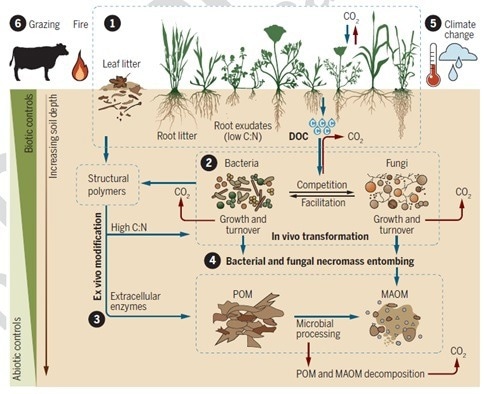Grasslands can store carbon, making them a valuable weapon in the fight against climate change. Researchers from the Chinese Academy of Sciences and Colorado State University have offered a new analysis of the existing research on soil carbon sequestration in grasslands, despite the fact that interest in grassland soil for carbon sequestration is not new.
 Conceptual framework for key factors and mechanisms controlling SOC sequestration in grassland ecosystems. Image Credit: Institute of Botany, The Chinese Academy of Sciences.
Conceptual framework for key factors and mechanisms controlling SOC sequestration in grassland ecosystems. Image Credit: Institute of Botany, The Chinese Academy of Sciences.
The researchers claim that they apply a novel paradigm of soil organic matter creation to their review and analyze grassland management for carbon sequestration through the lens of this paradigm and with consideration for regional differences.
On August 4th, 2022, the review article was published in the journal Science.
This is the first review which applies the new paradigm of soil organic matter formation and persistence to both discuss the effect of global changes on grasslands’ soil organic carbon and estimate the potentials of soil organic carbon sequestration of global grasslands.
Yongfei Bai, Study First Author, Institute of Botany, Chinese Academy of Sciences
Although it has been demonstrated that storing carbon in grassland soil is a feasible method of removing it from the atmosphere, the researchers say that additional research is still needed to gain a better knowledge of the topic and to develop recommendations for best practices.
In the past decade, there has been a paradigm shift in the understanding of the processes contributing to soil organic matter formation and persistence, which have highlighted the key role of microbial transformations and necromass on soil organic carbon accrual.
M. Francesca Cotrufo, Colorado State University
The majority of the organic carbon in soil is either mineral-associated organic matter (MAOM) composed of single small molecules eached from plant residues, or particulate organic matter (POM), which is made up of fragments of plant and microbial residues.
Because of its strong chemical bonds to minerals and physical protection in fine aggregates, MAOM contributes to longer-term carbon sequestration in soil than POM. With this knowledge, the researchers examined the relationship between soil carbon sequestration and grassland types, soil characteristics, and climate variables using the existing literature.
Our analysis presents capacities by different world regions and management strategies, thus facilitating policy and decision making.
Yongfei Bai, Study First Author, Institute of Botany, Chinese Academy of Sciences
For instance, the researchers discovered that 80% of European grasslands had the untapped potential for carbon sequestration because their carbon storage capacity was below saturation.
High levels of biodiversity are important for carbon storage, microbial diversity increases grass litter-derived POM stabilization efficiency but decreases MAOM stabilization efficiency, and ecosystems dominated by ectomycorrhizal fungi, such as savannas, shrublands, and forests, have 1.7 times more capacity for carbon sequestration per unit of soil nitrogen than ecosystems dominated by arbuscular mycorrhizal fungi.
The researchers also discovered that seasonal or rotational grazing had the least detrimental consequences and may even help soils store carbon. Continuous livestock grazing lowers plant cover, diversity, and productivity.
Cotrufo says, “We found that grassland ecosystems' plant and microbial biodiversity and functions can be restored by improving grassland management, leading to substantial carbon removal from the atmosphere thus contributing to climate change mitigation.”
Also, grassland responses are context dependent and management practices to restore their biodiversity and sequester carbon need to be implemented on the basis of their specific functionality and potential.
Cotrufo, M. F, Study Author
The researchers encourage rapid action in grassland restoration and management based on the knowledge at hand and existing understanding, while also recommending additional research to gather more data on understudied locations, such as the African savannas.
Bai concludes, “We hope for the incentivizing of grassland restoration management programs, in particular in the regions of the world where grasslands are most degraded, to prevent their further degradation due to global changes and overgrazing and optimize their utilization as atmospheric carbon sink.”
The current study was supported by the Chinese Academy of Sciences’ Strategic Priority Research Program and the National Natural Science Foundation of China.
Journal Reference:
Bai Y.& Cotrufo, M. F. (2022) Grassland soil carbon sequestration: Current understanding, challenges, and solutions. Science. doi.org/10.1126/science.abo2380.